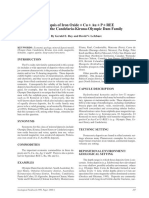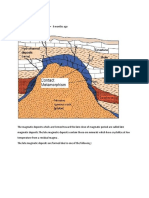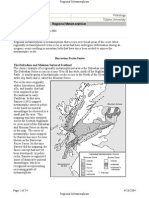0 ratings0% found this document useful (0 votes)
24 viewsOf For: of Tion Activity of
Of For: of Tion Activity of
Uploaded by
EndyMpeNkThis document discusses mineral deposits that form from magmatic processes. It describes the Minnamar copper-nickel deposit located in Minnesota's Duluth Complex. The deposit consists of disseminated copper and nickel minerals along the base of an intrusive gabbro unit, extending up to 750 meters deep. Higher grade portions of the deposit contain over 0.6% copper in zones at least 15 meters thick. The sulfide minerals present include cubanite, pyrrhotite, chalcopyrite, and pentlandite. The document also discusses models for immiscible liquid injection and the association between specific rock types and common magmatic ore minerals.
Copyright:
© All Rights Reserved
Available Formats
Download as PDF, TXT or read online from Scribd
Of For: of Tion Activity of
Of For: of Tion Activity of
Uploaded by
EndyMpeNk0 ratings0% found this document useful (0 votes)
24 views1 pageThis document discusses mineral deposits that form from magmatic processes. It describes the Minnamar copper-nickel deposit located in Minnesota's Duluth Complex. The deposit consists of disseminated copper and nickel minerals along the base of an intrusive gabbro unit, extending up to 750 meters deep. Higher grade portions of the deposit contain over 0.6% copper in zones at least 15 meters thick. The sulfide minerals present include cubanite, pyrrhotite, chalcopyrite, and pentlandite. The document also discusses models for immiscible liquid injection and the association between specific rock types and common magmatic ore minerals.
Original Title
92.pdf
Copyright
© © All Rights Reserved
Available Formats
PDF, TXT or read online from Scribd
Share this document
Did you find this document useful?
Is this content inappropriate?
This document discusses mineral deposits that form from magmatic processes. It describes the Minnamar copper-nickel deposit located in Minnesota's Duluth Complex. The deposit consists of disseminated copper and nickel minerals along the base of an intrusive gabbro unit, extending up to 750 meters deep. Higher grade portions of the deposit contain over 0.6% copper in zones at least 15 meters thick. The sulfide minerals present include cubanite, pyrrhotite, chalcopyrite, and pentlandite. The document also discusses models for immiscible liquid injection and the association between specific rock types and common magmatic ore minerals.
Copyright:
© All Rights Reserved
Available Formats
Download as PDF, TXT or read online from Scribd
Download as pdf or txt
0 ratings0% found this document useful (0 votes)
24 views1 pageOf For: of Tion Activity of
Of For: of Tion Activity of
Uploaded by
EndyMpeNkThis document discusses mineral deposits that form from magmatic processes. It describes the Minnamar copper-nickel deposit located in Minnesota's Duluth Complex. The deposit consists of disseminated copper and nickel minerals along the base of an intrusive gabbro unit, extending up to 750 meters deep. Higher grade portions of the deposit contain over 0.6% copper in zones at least 15 meters thick. The sulfide minerals present include cubanite, pyrrhotite, chalcopyrite, and pentlandite. The document also discusses models for immiscible liquid injection and the association between specific rock types and common magmatic ore minerals.
Copyright:
© All Rights Reserved
Available Formats
Download as PDF, TXT or read online from Scribd
Download as pdf or txt
You are on page 1of 1
92 PRoCESSESS OF FORMATIoN oF MINERAL DEPOSTTS
of intrusives. Other origins for the Sudbury ores
have been suggested.
Recent geological studies of the layered Duluth
Complex have resutted in a resurgence of explora-
tion activity and.success in discovering minerali-
zation and ore deposits. The Minnamar copper-
nickel deposit is a prime example that occurs in a
relatively uncomplicated southeasterly dipping se-
ries of formations that make-up a portion of the
Complex. The deposit is located 8 Km south of
Babbitt, Ir{innesota. It is localized along the base of
the Gabbro Complex and extends along a 5 Km
length of the gabbro contact and is about 2 km miles
in width.
Mineralization consists of disseminated copper
and nickel extending from the surface downdip to
a depth of 750 meters. Higher grade portions of the
deposit of >0.60 percent copper through a mini-
mum thickness of l5 meters ate the Bathtub deposit
on the west side that cxtends from 365 to 490 meters
in depth and the Tiger Boy deposit that extends
from 425 to 680 meters in depth. The sulfides are
principally cubanite, nonmagnetic pyrrtotitc, chal-
copyrite, and pentlandite. Scmc massive sulfides
are localized at the base of the mineralized intrusive
and also in the underlying hornfels.
Immiscible Liquid Injection. If the sulfide-rich frac-
tion accumulated in the manner described above,
and should be subjected to disturbance before con-
solidation, it might be squirted out toward places of
less pressure, such as sheared or brecciated areas
along the margins of the consolidated mother rock
or in the enclosing rocks. There it will consolidate
to form immiscible liquid injections. Such deposits
give unmistakable evidence of late magmatic age.
They intrude older rocks and enclose brecciated
fragments of foreign rock. They exhibit the intru-
sive relations of dikes. The ore minerals penetrate,
corrode, alter, and even replace the silicates. The
remnants of consolidation produce some hydroth-
ermal alteration of the surrounding silicates. The
deposits are irregular or dikelike in form. If the
residual fraction is rich in volatiles, the resulting
deposits might display transitions into hydrother-
mal types.
Flguro 5{ Generalized diagram ot'fiiinra
type intrusion. Black ditferentiated bssal zone
carrying nickelcopper sulphides.
(ArEr D. L
Scholtz. Geol. Soc. South Africa, 1936).
Examples of this class of deposit are thc Vlack-
fontein mine of South Africa and probably somc of
the Norway nickel deposits.
ASSOCTATION OF ROCKS AND MIT{ERAL
PRODUCTS
Definte associations exist between specific mag-
matic ores and certain kinds of rocks. Platinum
occurs only with mafic to ultramafic rock, nrch as
the varieties of norite, peridotite, or their aitcration
products. Chromite, with rare exceptions is found
only in peridotite, anorthosite, and similar mafic
rocks. Titaniferous magnetite and ilmenitc are
mothered by gabbro and anorthosite, and magrnatic
magnetite deposits occur with syenitc. Nickc[cop
per deposits are associated universally with norite,
and magmatic corundum with nepheline scycaitc.
Diamonds occur in comrnercial quantitics only in
kimberlite, a variety of peridotite. Pegmatitc min-
erals such as beryl, cassiterite, lepidolitc, schcclitc,
and niobium-bearing minerals occur chicf,y with
granitic rocks. It is thus seen that the decpscated
mafic rocks are the associates of most of the im-
portant magmatic mineral deposits, which indicates
a genetic relationship, probably during thc carly
magmatic history of mafic rocks.
Selected Readings on Magmatic Concentratioa
Bushveld igneous complex-Magmatic ore dcposits.
1969. J. Willemse. Econ. Geol. Mono., no.4, p. t-
22. Chronite, ntagnetite, and platinum dcposits.
Also vanadiferous magnetite.r, p. 187-208.
Occurrence and characteristics of chromite dcpsits-
Eastern Bushveld complex, 1969. Eugenc N. Cam'
eron and A. Desborough. Econ. Geol. Moao., no.
4, p. 23-40; also by E. N. Cameron, Econ- Geol.,
r.54 p.l15l-1213, 1959. Chrontite deposits af this
classical araa.
Stillwater, I{ontana, chromite deposits. 1969. Edward
Sampson. Econ. Geol. Mono.. no.4p.72-75.
Chromite seams--Great Dyke, Rhodesia. 1969. R- Bi.
cham. Econ. Geol. Mono., no. 4, p. 95-lll. Mag-
matic concenlration in separale intrusions-
Gravity Differentiation and llagmatic Podiform Chrom-
ite Deposits. 1969. T. P. Thayer. Ecoa. Geol.
You might also like
- 01 IronDocument21 pages01 IronvhinzsanguinaryNo ratings yet
- Syn-And Epigenetic Sulphides in Archean Bifs of Nw-Tanzania and Their Significance To Gold MineralisationDocument4 pagesSyn-And Epigenetic Sulphides in Archean Bifs of Nw-Tanzania and Their Significance To Gold Mineralisationprayer97551No ratings yet
- Porphyry DepositsDocument13 pagesPorphyry Depositsnasir.hdip8468100% (1)
- Porphyry Copper Deposits - 2 - by W.J. Mcmillan For The B.C. & Yukon Chamber of MinesDocument3 pagesPorphyry Copper Deposits - 2 - by W.J. Mcmillan For The B.C. & Yukon Chamber of MinesPatricio Castillo ManquecoyNo ratings yet
- Intoduction To Mineral DepositsDocument37 pagesIntoduction To Mineral Depositsjldbismanos01320No ratings yet
- Ultramafic Rock PDFDocument3 pagesUltramafic Rock PDFAwad MohammudNo ratings yet
- Tugas Mineragrafi 1 (Atlas Mineral)Document30 pagesTugas Mineragrafi 1 (Atlas Mineral)Dwi LekatompessyNo ratings yet
- Magmatic Ore DepositsDocument9 pagesMagmatic Ore DepositsSarif CB Clasik100% (1)
- Mineralization of Western SulawesiDocument20 pagesMineralization of Western SulawesiCaesesya AdrilaNo ratings yet
- Sedimentary Exhalative ZNDocument3 pagesSedimentary Exhalative ZNRicardo UmasiNo ratings yet
- A Synopsis of IOCG depositsDocument6 pagesA Synopsis of IOCG depositsCristian DiksonNo ratings yet
- 2008 EconomicGeology Shaoshan SkarnDocument30 pages2008 EconomicGeology Shaoshan SkarnPedro Luis TRUJILLO HERMITAÑONo ratings yet
- GY311 Lecture 5 Ores Hosted by Intermed.-Felisc Rocks - Rv2 - 2018Document7 pagesGY311 Lecture 5 Ores Hosted by Intermed.-Felisc Rocks - Rv2 - 2018Kennedy Oswald AikaruwaNo ratings yet
- Finlayson, 1909Document15 pagesFinlayson, 1909CesarVargasSalasNo ratings yet
- Skarn DepositsDocument7 pagesSkarn Depositsrenaldo100% (1)
- Mineralogy and Petrology OF Deposits: SkarnDocument15 pagesMineralogy and Petrology OF Deposits: Skarnmanael pixelNo ratings yet
- Late Magmatic Ore DepositsDocument20 pagesLate Magmatic Ore DepositsSyed Zaman100% (2)
- Kimberlites and Lamproites, Source of DiamondDocument16 pagesKimberlites and Lamproites, Source of DiamondMathilda TerusNo ratings yet
- MVT DepositsDocument12 pagesMVT DepositsulasaefNo ratings yet
- Assignment 2Document15 pagesAssignment 2AmyNo ratings yet
- Magmatic Ore DepositsDocument9 pagesMagmatic Ore DepositsSuta VijayaNo ratings yet
- Skarn Paper MyersDocument46 pagesSkarn Paper MyersEadwine Ed100% (1)
- Plate Tectonics and MineralizationDocument17 pagesPlate Tectonics and MineralizationAzhar Uddin100% (3)
- Skarn DepositsDocument75 pagesSkarn DepositsValentina Correa100% (1)
- SkarnsDocument5 pagesSkarnsAnonymous UnG9nqLNo ratings yet
- Economic Geology 5Document32 pagesEconomic Geology 5abush162223No ratings yet
- Advanced Argillic Alteration in BonanzaDocument10 pagesAdvanced Argillic Alteration in BonanzacreiderNo ratings yet
- GEOL350_FA24_M01_LN4 copyDocument20 pagesGEOL350_FA24_M01_LN4 copymalketbi175No ratings yet
- GeologyDocument10 pagesGeologyscribd.petition214No ratings yet
- Orthomagmatic CopperDocument4 pagesOrthomagmatic CopperDarrusalam UchihaNo ratings yet
- Materi 05 Endapan Magmatik CairDocument55 pagesMateri 05 Endapan Magmatik CairNandika Reza Faisal100% (2)
- South Korea: Corea Del SurDocument7 pagesSouth Korea: Corea Del SurJesus ChavezNo ratings yet
- Spatial and Temporal Rls of OreDocument19 pagesSpatial and Temporal Rls of Orevigneshdev2002No ratings yet
- Field Trips Stops For Days 1 & 2Document21 pagesField Trips Stops For Days 1 & 2Martin NguyenNo ratings yet
- Moritz Gold BRGM 2000Document7 pagesMoritz Gold BRGM 2000Hamdi PutraNo ratings yet
- 01 IronDocument21 pages01 IronJack Cole50% (2)
- Ore Deposits Related To Mafic and Ultramafic Rocks (B)Document17 pagesOre Deposits Related To Mafic and Ultramafic Rocks (B)KamalNo ratings yet
- 1 SMDocument9 pages1 SMSlimelifeucciNo ratings yet
- Volcanogenic Massive Sulphide DeopsitsDocument9 pagesVolcanogenic Massive Sulphide DeopsitsEka TaufikNo ratings yet
- Porphyry CuDocument6 pagesPorphyry CuHenrry Chipana PomaNo ratings yet
- VMS DepositDocument39 pagesVMS Depositrifky100% (1)
- Sub-Subtype 9.2.2.1: Algoma Bif: Geological Features and Genetic Models of Mineral Deposits 97Document1 pageSub-Subtype 9.2.2.1: Algoma Bif: Geological Features and Genetic Models of Mineral Deposits 97YeimsNo ratings yet
- RegionalmetamorphDocument14 pagesRegionalmetamorphapi-19643403No ratings yet
- Classification of Ore Deposits - Eco. Lec. No. 6, 2011Document25 pagesClassification of Ore Deposits - Eco. Lec. No. 6, 2011Suta VijayaNo ratings yet
- Quartz "Pods" - An Exploration Guide To Iron Oxide-Copper-Gold Mineralization?Document4 pagesQuartz "Pods" - An Exploration Guide To Iron Oxide-Copper-Gold Mineralization?John F. Cerron ZarccoNo ratings yet
- A Review OF THE Existing Hypotheses ON THE Origin OF THE Secondary Silicate Zones AT THE Contacts OF Intru-Sives With LimestonesDocument32 pagesA Review OF THE Existing Hypotheses ON THE Origin OF THE Secondary Silicate Zones AT THE Contacts OF Intru-Sives With Limestonesgeocarlos21No ratings yet
- Downes Et Al (2004) Mineral Deposits & Models of Cootamundra 250,000 Sheet AreaDocument38 pagesDownes Et Al (2004) Mineral Deposits & Models of Cootamundra 250,000 Sheet AreaJoshLeighNo ratings yet
- Ore GeologyDocument5 pagesOre GeologyRohith GowdaNo ratings yet
- 1473 FullDocument17 pages1473 FullBerthing HerreraNo ratings yet
- Endapan SkarnDocument40 pagesEndapan SkarnFrans AndersonNo ratings yet
- Types of Skarn DepositionDocument9 pagesTypes of Skarn DepositionMuhammad Fiendy Rianoor Azmi100% (1)
- Kimberlites and Lamproites Primary Sources of DiamondDocument12 pagesKimberlites and Lamproites Primary Sources of DiamondHellspawn.GeoNo ratings yet
- Areniscas NelsonDocument11 pagesAreniscas NelsonJaime RamosNo ratings yet
- Geology and Exploration of Porphyry Copper Deposits: in North Sulawesi, IndonesiaDocument17 pagesGeology and Exploration of Porphyry Copper Deposits: in North Sulawesi, IndonesiaazizNo ratings yet
- 06 Sillitoe Maricunga SEGDocument23 pages06 Sillitoe Maricunga SEGDiego Morales DíazNo ratings yet
- Orogenic Gold DepositsDocument4 pagesOrogenic Gold DepositsGiovanni PedemonteNo ratings yet
- Endapan SkarnDocument38 pagesEndapan SkarnCandra100% (1)
- Endapan MagmatikDocument3 pagesEndapan MagmatikRyanuarBachtiarNo ratings yet
- Lindgren 1935Document16 pagesLindgren 1935Harold G. Velasquez SanchezNo ratings yet
- VII of If l0 N N Will: DepositsDocument2 pagesVII of If l0 N N Will: DepositsEndyMpeNkNo ratings yet
- Img 20140704 0003 NewDocument1 pageImg 20140704 0003 NewEndyMpeNkNo ratings yet
- R " Lo-Dr Itr R'.: of T (RLDRDocument2 pagesR " Lo-Dr Itr R'.: of T (RLDREndyMpeNkNo ratings yet
- PR (U) of Of: VII Methd. Z ofDocument2 pagesPR (U) of Of: VII Methd. Z ofEndyMpeNkNo ratings yet
- Sixlliiion Fiarrl (': FortfDocument2 pagesSixlliiion Fiarrl (': FortfEndyMpeNkNo ratings yet
- Of o (R N But: L. .I For. LoDocument2 pagesOf o (R N But: L. .I For. LoEndyMpeNkNo ratings yet
- LL LL LL X20:: Px0'5 Vil.L2Document2 pagesLL LL LL X20:: Px0'5 Vil.L2EndyMpeNkNo ratings yet
- Vii.I I Of: The ThatDocument2 pagesVii.I I Of: The ThatEndyMpeNkNo ratings yet
- 27 28 PDFDocument2 pages27 28 PDFEndyMpeNkNo ratings yet
- Ttii'jh1 3 ,",,,S: U) ' Oo IsDocument2 pagesTtii'jh1 3 ,",,,S: U) ' Oo IsEndyMpeNkNo ratings yet
- 182 487 1 PB PDFDocument18 pages182 487 1 PB PDFEndyMpeNkNo ratings yet
- ilnl/ ( : .LLRRL Llcxitlrlitl'Oi /ltli Rcillity. TheDocument2 pagesilnl/ ( : .LLRRL Llcxitlrlitl'Oi /ltli Rcillity. TheEndyMpeNkNo ratings yet
- FLGRR": It Which (Fig. Liquid A With It. If Were Would Uid To To ItDocument1 pageFLGRR": It Which (Fig. Liquid A With It. If Were Would Uid To To ItEndyMpeNkNo ratings yet
- Proliles.: Z (X) Lo ofDocument1 pageProliles.: Z (X) Lo ofEndyMpeNkNo ratings yet
- 1 PDFDocument1 page1 PDFEndyMpeNkNo ratings yet
- 90 PDFDocument1 page90 PDFEndyMpeNkNo ratings yet
- Flguro Aligned Plagioclase Crystals Enclosed Liquid Ol Titano Bushveld ComplexDocument1 pageFlguro Aligned Plagioclase Crystals Enclosed Liquid Ol Titano Bushveld ComplexEndyMpeNkNo ratings yet
- LN For Of: To 5-l TheDocument1 pageLN For Of: To 5-l TheEndyMpeNkNo ratings yet













































































